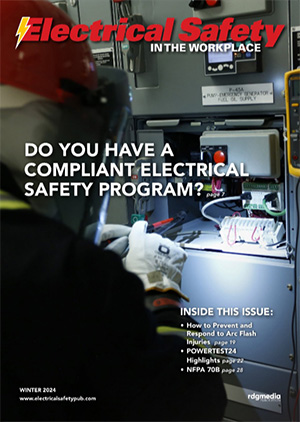A Guide to Key Updates in NFPA 70E
Are you aware of the new requirements that went into effect in May 2023?
By: Corey Hannahs, Contributor
In the ever-evolving landscape of electrical safety, staying abreast of the latest codes and standards requirements is crucial to ensuring the well-being of both employees and the workplace. Electrical contractors, safety directors and business owners have not only a legal obligation to ensure employee safety, but a moral obligation to do so.
To fulfill these obligations, it’s critical these parties are up to date on recent updates in the 2024 edition of NFPA 70E, Standard for Electrical Safety in the Workplace®. Updated every three years, NFPA 70E is about keeping employees safe. The standard outlines requirements for safe work practices that protect employees by reducing exposure to major electrical hazards such as electrocution, electrical shock, arc flash and arc blast.
The 2024 NFPA 70E was issued by the NFPA Standards Council on April 23, 2023, with an effective date of May 13, 2023, meaning any changes have been in effect for several months now. Below are some of the key changes to the standard.
GLOBAL CHANGES
- Electric Shock: The word “electric” has been placed before “shock” throughout the standard where it applies to an electric shock. This change will help ensure consistent use of the term. There are two terms: “hearing protection boundary” and “lung protection boundary” where the definitions use “shock” in a different context (e.g., shock wave).
- Protector: The word “leather” was deleted to acknowledge and allow the use of non-leather protectors.
- Definitions: All definitions have been relocated to Article 100 to comply with the NEC Style Manual.
- Scope: Scope statements have been added to each article in accordance with the NEC Style Manual.
ARTICLE 110 REVISIONS
Article 100 includes general requirements for electrical safety-related work practices, and revisions include:
110.2: This section introduces a new subsection structure titled “Electrically Safe Work Condition” (110.2(A), (B) and (C)).
110.2(A): A section titled “Policy” is added, incorporating content from former 110.1 and 110.5(K). This now requires employers to establish, document and implement an electrically safe work condition (ESWC) policy. Informational note No. 2 clarifies that the policy can be documented in the employer’s electrical safety program or other similar documents.
110.2(B): There is an added section titled “When Required,” using content from former 110.3 and 110.4. This provides the base statement of when an ESWC must be established. It then goes on to incorporate former 110.4 sections as exceptions to when an ESWC must be established. Exception No. 1 also adds a requirement for equipment to be rated for the available fault current as part of evaluating it as being in a normal operating condition. This was not a part of the requirement of a normal operating condition when this section previously resided in 110.4(D) in the 2021 edition of NFPA 70E.
110.2(C): A section titled “Requirements Until Established” is now included, which uses content from former 110.2 revised for clarity. This section clearly specifies that electrical conductors and circuit parts cannot be considered to be in an ESWC until all of the applicable requirements of 120.2 through 120.6 have been met. Applicable safe work practices must be utilized until an ESWC has been established.
110.3(I)(1): Item (3)(f) is added, identifying an emergency response plan as part of job safety planning. Identifying an emergency response plan up front, as part of the job safety planning, will facilitate a quicker response to electrical incidents that may occur.
110.4(A)(1): This is a revision to clarify that a qualified person must be qualified for specific equipment and tasks, changing “can” to “shall” for mandatory language. These requirements around qualified persons are just that: requirements. Therefore, the NEC Style Manual requires the use of mandatory language.
ARTICLE 120 REVISION
The requirements to establish an electrically safe work condition were revised for clarity:
120.6: Item (7) in the process for establishing an ESWC, regarding where to test for absence of voltage, is revised for clarity. Testing for absence of voltage must now be done “at each point of work.”
ARTICLE 130 REVISIONS
Revisions to work involving electrical hazards include:
130.4(E): Tables 130.4(E)(a) and 130.4(E)(b) are revised to align with Occupational Safety and Health Administration (OSHA) requirements.
130.5(H): Text was added to ensure that where equipment labels are being installed, they must be of sufficient durability to withstand the environment where the equipment is installed.
130.7(C)(5): This section was revised to clarify that hearing protection is now required for all employees inside the arc flash boundary.
130.8(M): There is a revision to mandate that a qualified person(s) determine the safety of re-energizing a circuit that is de-energized by the automatic operation of a circuit protective device (i.e., circuit breaker tripping). Additionally, the manual reclosing of circuit breakers or re-energizing circuits through replaced fuses is prohibited until the fault is cleared. A new exception was added that permits re-energizing a circuit without examining the circuit and connected equipment, provided that the automatic operation of the device was caused by an overload rather than a fault condition.
KEY TAKEAWAYS
The above changes are not comprehensive but provide an important overview of how the revisions introduced in the 2024 edition of NFPA 70E represent continuous improvement in electrical safety practices for employees. These updates collectively reinforce the standard’s commitment to adaptability and responsiveness to industry advancements and safety concerns.
Electrical contractors, safety directors, and business owners should be equally committed to adaptability and responsiveness, ensuring all electricians are properly trained to follow new guidelines. As organizations navigate the evolving landscape of electrical safety, adherence to the most up-to-date version of NFPA 70E is not just a compliance measure but a strategic investment in the integrity of electrical systems and employee safety. ESW
Corey Hannahs is a Senior Electrical Content Specialist with the National Fire Protection Agency (NFPA). For the 2024 edition of NFPA 70E — The Standard for Electrical Safety in the Workplace, please visit: https://www.nfpa.org/product/nfpa-70e-standard/p0070ecode.
Important Notice: Any opinion expressed in this column is the personal opinion of the author and does not necessarily represent the official position of NFPA or its Technical Committees. In addition, this piece is neither intended, nor should it be relied upon, to provide professional consultation or services.
Share on Socials!
Meet the new Panduit Absence of Voltage Testers
Electrical Safety Finds Its North Star
NFPA 70E® Training: A Springboard To Greater Safety And Health Performance Excellence
Leaders in Electrical Safety
• Aramark
• Bowtie Engineering
• Enespro
• Ericson
• I-Gard Corporation
• IRISS
• KERMEL, INC.
• Lakeland Industries
• MELTRIC Corporation
• National Safety Apparel
• National Technology Transfer
• Oberon
• Saf-T-Gard
• SEAM Group
Subscribe!
Sign up to receive our industry publications for FREE!







